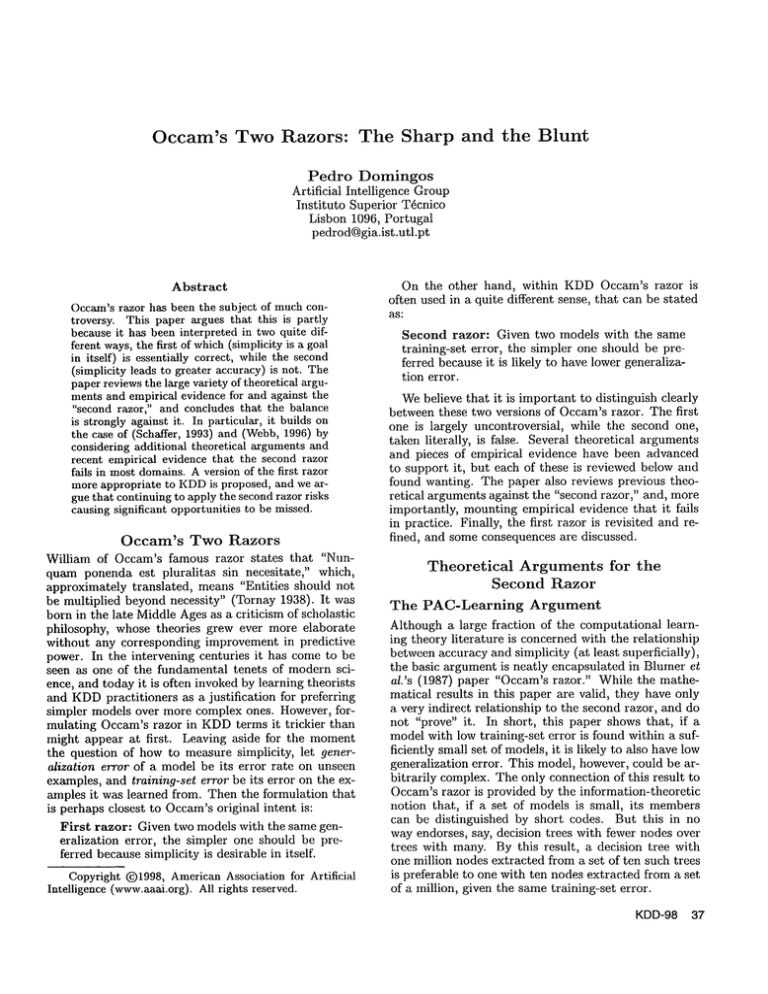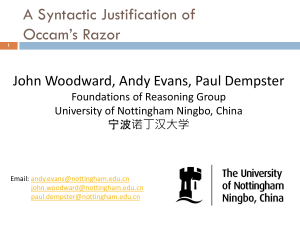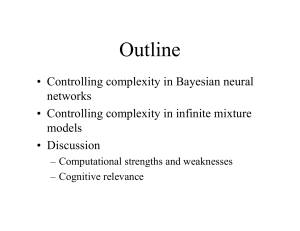
Occam’s Two Razors:
The Sharp and the Blunt
Pedro
Domingos
Artificial Intelligence Group
Instituto Superior T~cnico
Lisbon 1096, Portugal
pedrod@gia.ist.utl.pt
Abstract
Occam’srazor has been the subject of muchcontroversy. This paper argues that this is partly
because it has been interpreted in two quite different ways,the first of which(simplicity is a goal
in itself) is essentially correct, while the second
(simplicity leads to greater accuracy) is not. The
paper reviewsthe large variety of theoretical arguments and empirical evidence for and against the
"second razor," and concludes that the balance
is strongly against it. In particular, it builds on
the case of (Schaffer, 1993) and (Webb,1996)
considering additional theoretical argumentsand
recent empirical evidence that the second razor
fails in most domains.A version of the first razor
more appropriate to KDDis proposed, and we argue that continuingto apply the secondrazor risks
causing significant opportunities to be missed.
Occam’s
Two Razors
William of Occam’s famous razor states that "Nunquam ponenda est pluralitas sin necesitate," which,
approximately translated, means "Entities should not
be multiplied beyond necessity" (Tornay 1938). It was
born in the late Middle Ages as a criticism of scholastic
philosophy, whose theories grew ever more elaborate
without any corresponding improvement in predictive
power. In the intervening centuries it has come to be
seen as one of the fundamental tenets of modern science, and today it is often invoked by learning theorists
and KDDpractitioners as a justification for preferring
simpler models over more complex ones. However, formulating Occam’s razor in KDDterms it trickier than
might appear at first. Leaving aside for the moment
the question of how to measure simplicity, let generalization error of a model be its error rate on unseen
examples, and training-set error be its error on the examples it was learned from. Then the formulation that
is perhaps closest to Occam’soriginal intent is:
First razor: Given two models with the same generalization error, the simpler one should be preferred because simplicity is desirable in itself.
Copyright (~)1998, AmericanAssociation for Artificial
Intelligence (www.aaai.org).All rights reserved.
On the other hand, within KDDOccam’s razor is
often used in a quite different sense, that can be stated
as:
Second razor: Given two models with the same
training-set error, the simpler one should be preferred because it is likely to have lower generalization error.
Webelieve that it is important to distinguish clearly
between these two versions of Occam’srazor. The first
one is largely uncontroversial, while the second one,
taken literally, is false. Several theoretical arguments
and pieces of empirical evidence have been advanced
to support it, but each of these is reviewed below and
found wanting. The paper also reviews previous theoretical arguments against the "second razor," and, more
importantly, mounting empirical evidence that it fails
in practice. Finally, the first razor is revisited and refined, and some consequences are discussed.
Theoretical
The
Arguments
Second
Razor
PAC-Learning
for
the
Argument
Although a large fraction of the computational learning theory literature is concerned with the relationship
between accuracy and simplicity (at least superficially),
the basic argument is neatly encapsulated in Blumer et
al.’s (1987) paper "Occam’s razor." While the mathematical results in this paper are valid, they have only
a very indirect relationship to the second razor, and do
not "prove" it. In short, this paper shows that, if a
model with low training-set error is found within a sufficiently small set of models, it is likely to also have low
generalization error. This model, however, could be arbitrarily complex. The only connection of this result to
Occam’srazor is provided by the information-theoretic
notion that, if a set of models is small, its members
can be distinguished by short codes. But this in no
way endorses, say, decision trees with fewer nodes over
trees with many. By this result, a decision tree with
one million nodes extracted from a set of ten such trees
is preferable to one with ten nodes extracted from a set
of a million, given the same training-set error.
KDD-98 37
Put another way, the results in (Blumer et al. 1987)
only say that if we select a sufficiently small set of roodcls prior to looking at the data, and by goodfortune one
of those models closely agrees with the data, we can be
confident that it will also do well on future data. The
theoretical results give no guidance as to howto select
that set of models.
Similar remarks apply to the more recent work of
MacKay(1992). The "Occam factors" that appear
his evidence framework penalize model structures with
many parameters, as opposed to models, and can also
lead to suboptimal choices.
The Bayesian
Argument
Claims of a general theoretical foundation for preferring simple models can also be found in the statistical and pattern recognition literature.
While the
details vary, they typically take the form of an approximation to the optimal prediction procedure of
Bayesian model averaging (Bernardo & Smith 1994;
Chickering & Heckerman1997) that results in evaluating candidate models according to a sum of two terms:
an error or likelihood term, and a term penalizing the
complexity of the model. Criteria of this type include
AIC (Alcaike 1978), BIC (Schwarz 1978), and many
ers. Similar criteria with an information-theoretic interpretation,
like MML(Wallace & Boulton 1968) and
MDL(Rissanen 1978) are discussed below.
Consider BIC, the first criterion to be explicitly proposed as an approximation to Bayesian model averaging. Leaving aside the fact that BIC involves a sequence
of approximations and assumptions that may or may
not be valid in practice (e.g., an infinite sample), its
use of a complexity penalty does not imply that simpler models are more probable, because BIC computes
probabilities for model structures, as opposed to models. This distinction is important, ax+b and ax2 +bx+c
are model structures; each can be instantiated by many
different models, for example 5x + 2 and 3x2 + x + 10.
BIC approximates the inarginal likelihood of a model
structure, which is the average of the likelihoods of all
the models that instantiate it (weighted by their prior
probahilities given the model structure). BIC penalizes the model structure’s dimension because higherorder spaces effectively contain manymore models than
lower-order ones, and thus contain many more lowlikelihood models along with the "best" one(s). (In precise terms, higher-order model structures have a higher
VCdimension (Haussler 1988); or, considering finiteprecision numbers, they literally contain more models.)
For example, the model space defined by ~lx 2 + bx + c
contains many more models than the one defined by
a:c + b. Thus, if the correct model is 3x2 + x + 10, the
quadratic structure is correspondingly the correct one,
but it maystill appear less likely than the lineal" structure, because the high likelihood of the 3x2 + x + 10
model will be averaged with a large number of vanishingly small likelihoods corresponding to the manypoor
quadratic models that are possible. However, this has
no bearing on the likelihood of the 3x2 +x+ 10 model; it
will still be morelikely than any linear model, irrespect, ive of its quadratic degree. Thus, choosing a model
structure according to BIC and then instantiating the
parameters can lead to a suboptimal model.
The minimumdescription length (MDL)principle (Rissanen 1978) is perhaps the form in which the second
razor is most often applied (e.g., (Quinlan & Rivest
1989)). Accordingto this principle, the "best" model
the one which minimizes the total numberof bits needed
to encode the model and the data. The MDLprinciple
is appealing because it reduces two apparently incommensurable attributes of a model (error rate and complexity) to the same form: bits of information. However, there is no gum’anteethat it will select the most
accurate model. Rissanen simply proposes it as a fundamental principle. The closely-related minimummessage
length (MML)principle (Wallace & Boulton 1968)
derived by taking the logarithm of Bayes’ theorenl and
noting that, according to information theory (Cover
Thomas1991), logarithms of probabilities can be seen
as (minus) the lengths of the most efficient codes for the
corresponding events. This has led some researchers to
believe that a trade-off between error and complexity is
"a direct consequence of Bayes’ theorem, requiring no
additional assumptions" (Cheeseman 1990). However,
this belief is founded on a confusion between assigning the shortest codes to the most probable hypotheses
and a priori considering that the syntactically simplest
models in the representation being used (e.g., the decision trees with fewest nodes) are the most probable
ones. If they have higher priors, more complex models
can be assigned shorter codes, but this obviously does
not imply any preference for simpler models in the original representation (e.g., if the modelwith highest prior
is a decision tree with a million nodes, it can be assigned
a 1-bit code, without this implying any preference for
small trees.)
Information theory, whosegoal is the efficient use of
a transmission channel, has no direct bearing on KDD,
whose goal is to infer predictive and comprehensible
models from data. Having assigned a prior probability
to each model in the space under consideration, we can
always recode all the models such that the most probable ones are represented by the shortest bit strings.
However, this does not make them more predictive, and
is unlikely to make them more comprehensible.
38 Domingos
The Information-Theoretic
Theoretical
"Zero-Sum"
Argument
Arguments
Against
Second
Razor
the
Arguments
A uumber of well-known theoretical results have been
established which imply that the second razor cannot
be true. These results include Schaffer’s (1994) conservation law of generalization performance and Wolpert’s
(1996) "no free lunch" theorems, and are in turn implicit in Mitchell’s (1980) demonstration that bias-free
learning is impossible. In essence, they imply that, for
every domain where a simpler model is more accurate
than a more complex one, there exists a domain where
the reverse is true, and thus that no argument about
which is preferable in general can be made. Although
these results negate the second razor in a mathematical
sense, they still leave open the possibility that it will
apply in most (or all) real-world domains (Rao, Gordon, & Spears 1995). This is a matter for empirical
study, which the next two sections address.
The Vapnik-Chervonenkis
Dimension
In his sophisticated theory of learning, Vapnik (1995)
showsthat the generalization ability of a class of models is not a function of its number of parameters, but
of its VCdimension. Although the two are sometimes
related, in general they are not. Modelstructures with
a very large number of parameters can generalize quite
reliably, if constrained in other ways. The model structure class = sign(sin ax), with a single parameter, has
an infinite VCdimension, because it can discriminate
an arbitrarily large, arbitrarily labeled set of points on
the x axis (Vapnik 1995, p. 78).
Overfitting
Is Due to Multiple
Testing
According to conventional wisdom, overfitting is caused
by overly complex models, and Occam’s razor combats it by introducing a preference for simpler ones.
However, Cohen and Jensen (1997) have shown that
overfitting in fact arises not because of complexity per
se, but because attempting a large number of models leads to a high probability of finding a model that
fits the training data well purely by chance. Attempting 10 complex models incurs a smaller risk of overfitting than attempting 100 simple ones. Overfitting is
thus best combatted not by the second razor, but by
taking this multiple testing phenomenoninto account
when scoring candidate models (Jensen &: Schmill 1997;
Domingos 1998).
in most real-world situations."
This section and the
next attempt to determine if this is indeed the case.
Pruning
A simple empirical argument for the second razor might
be stated as "Pruning works." Indeed, pruning often
leads to models that are both simpler and more accurate
than the corresponding unpruned ones (Mingers 1989).
However, it can also lead to lower accuracy (Schaffer
1993). It is easy to think of simple problems where
pruning can only hurt accuracy (e.g., applying a decision tree algorithm like C4.5 to learning a noise-free,
diagonal frontier).
More importantly, as mentioned
above, Cohen and Jensen (1997) have shown persuasively that pruning should not be seen as a correction
of overly complex models, but as an effective reduction
of the number of models attempted. In a related paper,
Jensen and Schmill (1997) have shown empirically that
correcting for multiple testing when pruning leads to
better results than MDLand related methods.
The 1R Algorithm
In an oft-cited paper, Holte (1993) observes that
decision tree containing a single node can sometimes
come reasonably close to C4.5 in accuracy. However, in
Holte’s experiments his 1R ("l-rule") algorithm was
average 5.7% less accurate than C4.5, which is hardly
negligible. The closest results to C4.5 were obtained
by the 1R. measure, which finds the accuracy of the
best possible 1-rule by looking at the test set. These
results appear to have led to some confusion. As Holte
points out, 1R* is a measure, not an algorithm; it makes
no sense to consider its accuracy "competitive" with
C4.5’s. A similar measure for decision trees would always achieve the Bayes rate (lowest error possible).
most, these experiments suggest that the advantage of
going to more complex models is small; they do not
imply that simpler models are better (Elomaa 1994).
However,as we shall see below, more recent results call
even this conclusion into question.
Other
Bias-Variance
Schuurmans et al. (1997) have shown that complexitypenalty methods assume a particular bias-variance profile, and that if the true profile does not correspond to
the postulated one systematic underfitting or overfitting will result. Thus these methods can only be optimal in very specific cases.
Empirical
Evidence
for the
Second
Razor
Arguably, most KDDresearchers who routinely apply
the second razor do not believe that it is universally
true, but simply that it generally applies in practice.
For example, Piatetsky-Shapiro (1996) argues that "Occam’s razor is not ’ALWAYS’
true - but is mostly true
Low-Variance
Algorithms
More generally, several pieces of recent work (e.g.,
(Friedman 1996; Domingos & Pazzani 1997)) have suggested that simple learners like the naive Bayesian clas~;fier or the perceptron will often do better than more
~omplex ones because, while having a higher systematic
error component(the bias), they are less prone to randomfluctuations (the variance). Again, these results
do not imply a preference for simpler models, but for
restricting search. Suitably constrained, decision-tree
or rule induction algorithms can be as stable as simpler ones, and more accurate. Theory revision systems
(e.g., (Ourston & Mooney 1994)) are an example
this: they can produce accurate theories that are quite
complex with comparatively little search, by making incremental changes to an initial theory that is already
complex.
KDD-98 39
Physics,
Etc.
The second razor is often justified by pointing to its
success in the "hard" sciences. (Although these arguments are fuzzier, they should still be addressed, because they form a large part of tile razor’s appeal.)
popular example comes from astronomy, where it favors
Copernicus’ model of the solar system over Ptolemy’s.
Ironically, in terms of predictive error the two models
are indistinguishable, since they predict the same trajectories. Copernicus’s model is preferable oll the intrinsic merits of simplicity (first razor). Analternative,
slightly humorousexample is provided by flat earth vs.
spherical earth. The second razor clearly favors the fiat
earth theory, being a linear model, while the spherical
one is quadratic and no better at explaining everyday
observations in the Middle Ages.
Another favorite example is relativity vs. Newton’s
laws. The following passage is from (Cover & Thomas
1991):
In the end, we choose the simplest explanation that
is consistent with the observed data. For example,
it is easier to accept the general theory of relativity
than it is to accept a correction factor of c/r a to
the gravitational law to explain the precession of
the perihelion of Mercury, since the general theory
explains more with fewer assumptions than does a
"patched" Newtonian theory.
In fact, the general theory of relativity makes more
assmnptions than Newton’sgravitational law, and is far
more complex, so this cannot be the reason for preferring it. The preference comes from the fact that the
c/r 3 factor is a t)atch, applied to (over)fit the theory
a particular observation. As Pearl (1978) insightfully
notes:
It would, therefore, be more appropriate to connect
credibility with the nature of the selection proce(lure rather than with properties of the final product. Whenthe former is not explicitly known...
simplicity merely serves as a rough indicator for
the type of processing that took place prior to discovery.
Yet another example is Maxwell’s four concise and
elegant equations of electromagnetism. In fact, these
equations are concise and elegant only in the notation
of differential operators that was introduced manyyears
after his death. In their original form, they were long
and unwieldy, leading Faraday to complain of their incomprehensibility, which precluded him from empirically testing them.
The list goes on. In any case, the fact that comparatively simple equations have proved successfnl in modcling many physical phenomena is no indication that
the same will be true in the large variety of areas KDD
is being applied to medicine, finance, earth sensing,
molecular biology, marketing, process control, fault detection, and manyothers.
40 Domingos
Empirical
Evidence
Against
Second
Razor
the
Several authors have carried out ext)eriments that directly or indirectly investigate the relationship between
simplicity and accuracy, and obtained results that contradict tile second razor. Fisher and Schlimmer(1988)
observed that concept simplification
only sometimes
improved accuracy in tile ID3 and COBWEB
systems,
and that this was dependent on the training set size
and the degree of dependence of the concept on the attributes. Murphyand Pazzani (1994) induced all consistent decision trees for a numberof small, noise-free
domains, and found that in many cases the smallest
trees were not the most accurate ones. Schaffer (1993)
conducted a series of experiments showing that pruning
can increase error, and that this effect can increase with
the noise level. Quinlan and Cameron-Jones (1995) and
Murthy and Salzberg (1995) found that excessive search
often leads to models that are simultaneously simpler
and less accurate. Webb(1996; 1997) showed that, remarkably, the accuracy of decision trees on common
datasets can be consistently increased by grafting additional nodes onto the tree, even after the data has
been perfectly fit. Chickering and Heckerman(1997)
compared sevm’al different methods for approximating
the likelihood of simple Bayesian model structures, and
found that the BIC/MDLapproach was ahnost always
the least accurate one. Lawrence et al. (1997) conducted experiments with backpropagation in synthetic
domains, and found that training neural networks larger
than the correct one led to lower errors than training
networksof tile correct size.
Another source of evidence against the second razor is the growing number of practical machine learning systems that achieve reductions in error by learning more complex models.
Vapnik’s (1995) support vector machines learn polynomials of high degree (and resulting feature spaces of dimension up to
1016), and outperformed simpler state-of-the-art
models in the USPShandwritten digit recognition database.
Cestnik and Bratko (1988), Gams (1989) and Datta
and Kibler (1995) show how redundancy can improve
noise resistance and therefore accuracy. Domingos’
(t996) RISE system consistently outperforms CN2and
C4.5/C4.5RULES on common datasets
by inducing
substantially
more complex rule sets. Webb’s abovementioned decision-tree grafting is another example.
Schuurmans (1997) has proposed a geometric evaluation measure that markedly outperforms complexitypenalty ones in polynomial regression tasks.
Arguably, practical experience with MDL-basedsystems themselves provides evidence against the second
razor. For example, after spending considerable effort
to find a good coding for trees and examples, Qninlan
and Rivest (1989) found that better results were obtained by introducing an ad hoc coefficient to reduce
the penalty paid by complex decision trees.
Finally, the success of multiple-model approaches
in almost all commonly-useddatasets (e.g., (Quinlan
1996)) shows that large error reductions can systematically result from sharply increased complexity. In particular, Rao and Potts (1997) show how bagging builds
accurate frontiers from CARTtrees that approximate
them poorly, and Domingos(1997b) shows how a single
model learned by emulating the behavior of a bagged
ensemble is both more complex and more accurate than
a model induced directly from the data by the same
learner (C4.5RULES).
All of this evidence points to the conclusion that not
only is the second razor not true in general; it is also
typically false in the types of domains KDDhas been
applied to.
The First
Razor Revisited
The true reason for preferring simpler models is that
they are easier for us to understand, rememberand use
(as well as cheaper for computers to store and manipulate). Thus the first razor is justified. However,simplicity and comprehensibility are not always equivalent.
For example, a decision table (Langley 1996) may
larger than a similarly accurate decision tree, but more
easily understood because all lines in the table use the
same attributes. Induced models are also more comprehensible if they are consistent with previous knowledge,
even if this makes them more complex (Pazzani, Mani,
& Shankle 1997). A better form of the first razor would
perhaps state that given two models with the same generalization error, the more comprehensible one should
be preferred. What exactly makes a model comprehensible is largely domain-dependent,but also a matter for
cognitive research.
Discussion
All the evidence reviewed in this paper showsthat, contrary to the second razor’s claim, greater simplicity does
not necessarily (or even typically) lead to greater accuracy. Rather, care must be taken to ensure that the
algorithm does not perform more search than the data
allows, but this search can (and often should) be performed among complex models, not simple ones.
The second razor can be trivially made true by, after the fact, assigning the simplest representations to
the most accurate models found. However, this is of no
help in finding those models in the first place. Using
"simple model" as just another way of saying "probable
model" or "model from a small space," as is often done
in the literature, constitutes a multiplication of entities
beyond necessity, and thus runs afoul of the first razor, which is as applicable to KDDresearch as to other
branches of science. More importantly, it can lead to
the misconception that simpler models in the initial,
commonly-usedrepresentation (e.g., a decision tree or
a list of rules) are for some reason more likely to be
true.
The second razor will be appropriate when we really
believe that the phenomenon under study has a sim-
ple model in the representation
language used. But
this seems unlikely for the domains and representations KDDtypically deals with, and the empirical evidence bears this out. More often, the second razor
seems to function as a poor man’s substitute for domain knowledge---a way of avoiding the complexities
of adjusting the system to the domain before applying it to the data. Whenthis happens, overfitting may
indeed be avoided by use of the second razor, but at
the cost of detectable patterns being missed, and unnecessarily low accuracy being obtained. The larger
the database, the likelier this is. Databases with millions or tens of millions of records potentially contain
enough data to discriminate among a very large number of models. Applying the second razor when mining
them risks rediscovering the broad regularities that are
already familiar to the domainexperts, and missing the
second-order variations that are often where the payoff
of data mining lies.
Systems that allow incorporation
of domain constraints (e.g, (Clearwater & Provost 1990; Clark
Matwin 1993; Lee, Buchanan, & Aronis 1998)) are
alternative to blind reliance on simplicity. Incorporating such constraints can simultaneously improve accuracy (by reducing the search needed to find an accurate
model) and comprehensibility (by making the results
induction consistent with previous knowledge). Weak
constraints are often sufficient ((Abu-Mostafa 1989;
Donoho & Rendell 1996; Pazzani, Mani, & Shankle
1997); see also (Bishop 1995), Section 8.7). If we
cept the fact that the most accurate models will not
always be simple or easily understandable, we should
allow an explicit trade-off between the two. Systems that first induce the most accurate model they
can, and then extract from it a more comprehensible model of variable complexity (e.g., (Craven 1996;
Domingos 1997a)) seem a promising avenue.
Conclusion
Occam’s razor can be interpreted in two ways: as favoring the simpler of two models with the same generalization error because simplicity is a goal in itself, or
as favoring the simpler of two models with the same
training-set error because this leads to lower generalization error. This paper found the second version to
be provably and empirically false, and argued that in
the first version simplicity is only a proxy for comprehensibility. A resulting prescription for KDDresearch
and applications is to prefer simpler models only when
we honestly believe the target phenomenonto be simple. Given that this is seldom the case in practice, we
should instead seek to constrain induction using domain
knowledge, and decouple discovering the most accurate
(and probably quite complex) model from extracting
comprehensible approximations to it.
KDD-98 41
References
Abu-Mostafa, Y. S. 1989. Learning from hints in neural networks. Journal of Complexity 6:192-198.
A "kaike, H. 1978. A Bayesian analysis of tile minimum
AICt)rocedure. Annals of the Institute of Statistical
Mathematics 30A:9-14.
Bernardo, J. M., and Smith, A. F. M. 1994. Bayesian
Theory. NewYork, NY: Wiley.
Bishop, C. M. 1995. Neural Networks for Pattern
I~ecognition. Oxford, UK:Oxford University Press.
Blumer, A.; Ehrenfeueht, A.; Haussler, D.; and Warmuth, M. K. 1987. Occam’s razor. Information Processing Letters 24:377 380.
Cestnik, B., and Bratko, I. 1988. Learning redundant
rules in noisy domains. In Proceedings of thc Eighth
European Conference on Artificial Intelligence, 348
356. Munich, Germany: Pitman.
Cheeseman, P. 1990. On finding the most probable
model. In Shrager, J., and Langley, P., eds., Computational Models of Scientific Discovery and Theory
Formation. San Mateo, CA: Morgan KaufInann. 7395.
Chickering, D. M., and Heckerman, D. 1997. Efflcent
apl)roximations for the marginal likelihood of Bayesian
networks with hidden variables. Machine LeaTwing
29:181-212.
Clark, P., and Matwin, S. 1993. Using qualitative
models to guide inductive learning. In Proceedings
of the Tenth h~ternational Conference on Machine
Learning, 49-56. Amherst, MA:Morgan Kaufinann.
Clearwater, S., and Provost, F. 1990. RL4: A tool for
knowledge-basedinduction. In Proceedings of the Second IEEE International Conference on Tools for Artificial httelligence, 24-30. San Jose, CA: IEEE Computer Society Press.
Cohen, P. R., and Jensen, D. 1997. Overfitting explained. In Preliminary Papers of the Sixth International Workshopon Artificial httelligenee and Statistics, 115-122. Fort Lauderdale, FL: Society for Artificial Intelligence and Statistics.
Cover, T. M., and Thomas, J. A. 1991. Elements of
Information Theory. NewYork, NY: Wiley.
Craven, M. W. 1996. Extracting Comprehensible Models from Trained Neural Networks. Ph.D. Dissertation,
Department of Computer Sciences, University of Wisconsin Madison, Madison, WI.
Datta, P., and Kibler, D. 1995. Learning prototypical
concept descriptions. In Proceedings of the Twelfth
h~ternational Conference on Machine Learning, 158166. Tahoe City, CA: Morgan Kaufinann.
Domingos, P., and Pazzani, M. 1997. On the optimality of the simple Bayesian classifier under zero-one
loss. Machine Learning 29:103 130.
Domingos,P. 1996. Unifying instance-based and rulebased induction. Machine Learning 24:141-168.
42 Domingos
Domingos, P. t997a. Knowledge acquisition
from
examples via inultiple
models. In Proceedings of
the Fourteenth International Conference on Machine
Learning, 98 106. Nashville, TN: Morgan Kaufinann.
Domingos, P. 1997b. Why does bagging work? A
Bayesian account and its implications. In PTvceedings
of the Fourth International Conference on I(nowledge
Discovery and Data Mining, 155-158. Newport Beach,
CA: AAAIPress.
Domingos, P. 1998. A process-oriented heuristic for
model selection. In Proceedings of the Fifteenth International Conference on Machine Learning. Madison,
WI: Morgan Kaufinann.
Donoho,S., and Rendell, L. 1996. Constructive induction using fragmentary knowledge. In PTvceedings of
the Thirteenth h~ternational Conference on Machine
Learning, 113-121. Bari, Italy: Morgan Kaufinann.
Elomaa, T. 1994. In defense of C4.5: Notes on learning
one-level decision trees. In Pwceedingsof the Eleventh
International Conference on Machine Learning, 6269. NewBrunswick, N J: Morgan Kaufinann.
Fisher, D. H., and Schlimmer, J. C. 1988. Concept
simplification and prediction accuracy. In Proceedings of the Fifth bzteT~mtional Conference on Machine
Learning, 22-28. Ann Arbor, MI: Morgan Kaufmann.
Friedman, J. H. 1996. On bias, variance, 0/1 - loss,
and the curse-of-dimensionality. Technical report, Department of Statistics and Stanford Linear Accelerator Center, Stanford University, Staifford, CA. ftp://playfair.stanford.edu/pub/friedman/kdd.ps.Z.
Gains, M. 1989. New measurements highlight the
importance of redundant knowledge. In Proceedings
of the Fourth European Working Session on Learning,
71 79. Montpellier, France: Pitman.
Haussler, D. 1988. Quantifying inductive bias: AI
learning algorithms and Valiant’s learning framework.
Artificial Intelligence 36:177-221.
Holte, R. C. 1993. Very simple classification rules perform well on most commonlyused datasets. Machine
Learning 11:63-91.
Jensen, D., and Schmill, M. 1997. Adjusting for multiple conlparisons in decision tree pruning. In Proceedings of the Fourth International Conferenceon If howledge Discovery and Data Mining, 195-198. Newport
Beach, CA: AAAIPress.
Langley, P. 1996. Induction of condensed determinations. In Proceedings of the Second hzternational
Conference on Knowledge Discovery and Data Mining, 327-330. Portland, OR: AAAIPress.
Lawrence, S.; Giles, C. L.; and Tsoi, A. C. 1997.
Lessons in neural network training: Overfitting may
be harder than expected. In Proceedings of the Fourteenth National Conference on Artificial Intelligence,
540-545. Providence, RI: AAAIPress.
Lee, Y.; Buchanan, B. G.; and Aronis, J. M.
1998. Knowledge-based learning in exploratory sci-
ence: Learning rules to predict rodent carcinogenicity.
Machine Learning 30:217-240.
MacKay, D. 1992. Bayesian interpolation.
Neural
Computation 4:415-447.
Mingers, J. 1989. An empirical comparison of pruning
methods for decision tree induction. MachineLearning
4:227-243.
Mitchell, T. M. 1980. The need for biases in learning
generalizations. Technical report, Rutgers University,
Computer Science Department, New Brunswick, NJ.
Murphy, P., and Pazzani, M. 1994. Exploring the
decision forest: An empirical investigation of Occam’s
razor in decision tree induction. Journal of Artificial
Intelligence Research 1:257-275.
Murthy, S., and Salzberg, S. 1995. Lookahead and
pathology in decision tree induction. In Proceedings
of the Fourteenth International Joint Conference on
Artificial Intelligence, 1025-1031. Montr6al, Canada:
Morgan Kaufmann.
Ourston, D., and Mooney, R. J. 1994. Theory refinement combining analytical and empirical methods.
Artificial Intelligence 66:273-309.
Pazzani, M.; Mani, S.; and Shankle, W. R. 1997. Beyond concise and colorful: Learning intelligible rules.
In Proceedings of the Fourth International Conference
on Knowledge Discovery and Data Mining, 235-238.
Newport Beach, CA: AAAIPress.
Pearl, J. 1978. On the connection between the complexity and credibility of inferred models. International Journal of General Systems 4:255-264.
Piatetsky-Shapiro,
G. 1996. Editorial comments.
KDDNuggets 96:28.
Quinlan, J. R., and Cameron-Jones, R. M. 1995.
Oversearching and layered search in empirical learning. In Proceedings of the Fourteenth International
Joint Conference on Artificial Intelligence, 1019-1024.
Montr@al, Canada: Morgan Kaufmann.
Quinlan, J. R., and Rivest, R. L. 1989. Inferring
decision trees using the minimumdescription length
principle. Information and Computation 80:227-248.
Quinlan, J. R. 1996. Bagging, boosting, and C4.5. In
Proceedings of the Thirteenth National Conference on
Artificial Intelligence, 725 730. Portland, OR: AAAI
Press.
Rao, J. S., and Potts, W. J. E. 1997. Visualizing
bagged decision trees. In Proceedings of the Fourth
International Conference on Knowledge Discovery and
Data Mining. Newport Beach, CA: AAAIPress.
Rao, R. B.; Gordon, D.; and Spears, W. 1995. For
every action, is there really an equal and opposite reaction? Analysis of the conservation law for generalization performance. In Proceedings of the Twelfth
International Conference on Machine Learning, 471479. Tahoe City, CA: Morgan Kanfmann.
Rissanen, J. 1978. Modeling by shortest data description. Automatica 14:465-471.
Schaffer, C. 1993. Overfitting avoidance as bias. Machine Learning 10:153 178.
Schaffer, C. 1994. A conservation law for generalization performance. In Proceedings of the Eleventh
International Conference on Machine Learning, 259
265. New Brunswick, NJ: Morgan Kaufmann.
Schuurmans, D.; Ungar, L. H.; and Foster, D. P.
1997. Characterizing the generalization performance
of model selection strategies.
In Proceedings of
the Fourteenth International Conference on Machine
Learning, 340-348. Nashville, TN: Morgan Kauflnann.
Schuurmans, D. 1997. A new metric-based approach
to model selection. In Proceedings of the Fourteenth
National Conference on Artificial Intelligence, 552558. Providence, RI: AAAIPress.
Schwarz, G. 1978. Estimating the dimension of a
model. Annals of Statistics 6:461-464.
Tornay, S. C. 1938. Ockham: Studies and Selections.
La Salle, IL: Open Court.
Vapnik, V. N. 1995. The Nature of Statistical Learning
Theory. NewYork, NY: Springer-Verlag.
Wallace, C. S., and Boulton, D. M. 1968. An information measure for classification.
Computer Journal
11:185-194.
Webb, G. I. 1996. Further experimental evidence
against the utility of Occam’srazor. Journal of Artificial Intelligence Research 4:397-417.
Webb,G. I. 1997. Decision tree grafting. In Proceedings of the Fifteenth International Joint Conference on
Artificial Intelligence, 846-851. Nagoya, Japan: Morgan Kaufmann.
Wolpert, D. 1996. The lack of a priori distinctions
between learning algorithms.
Neural Computation
8:1341 1390.
KDD-98 43







